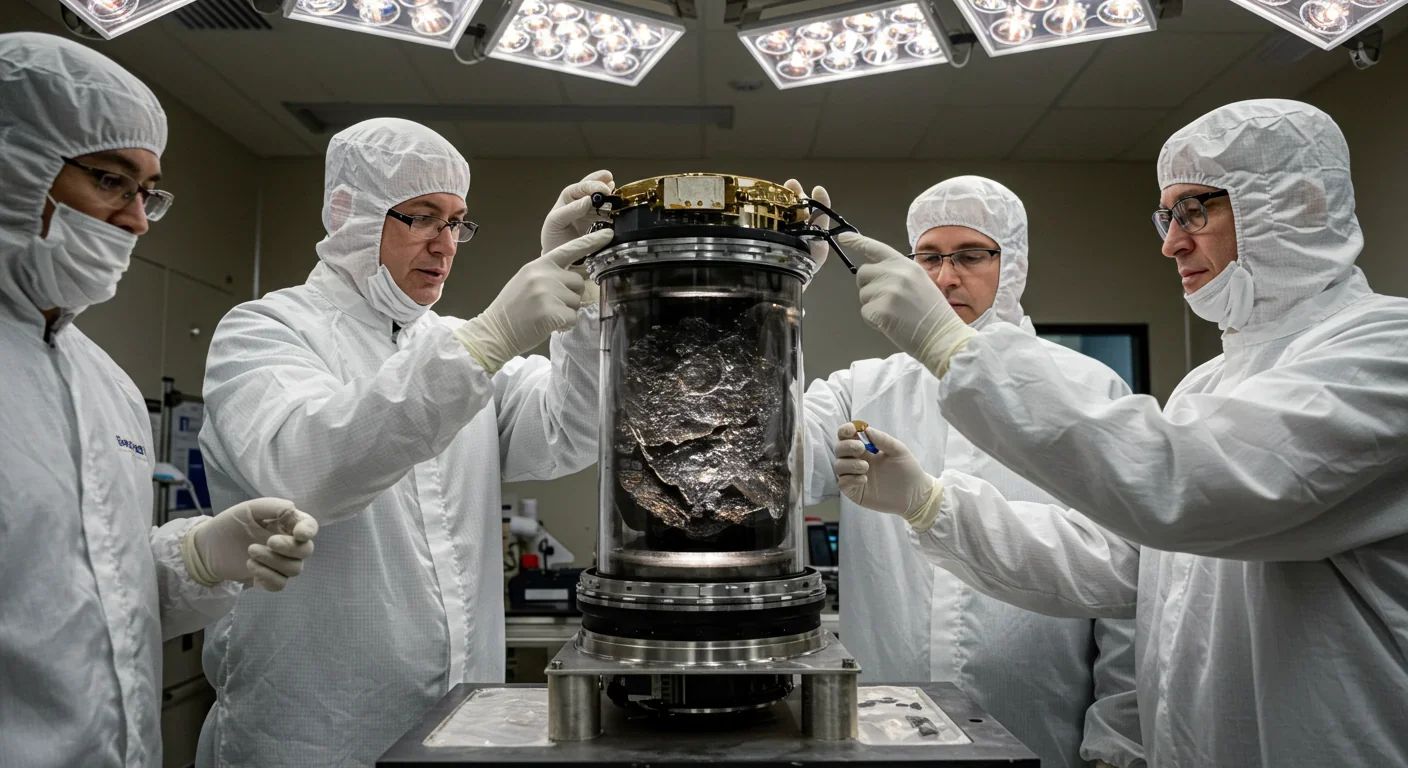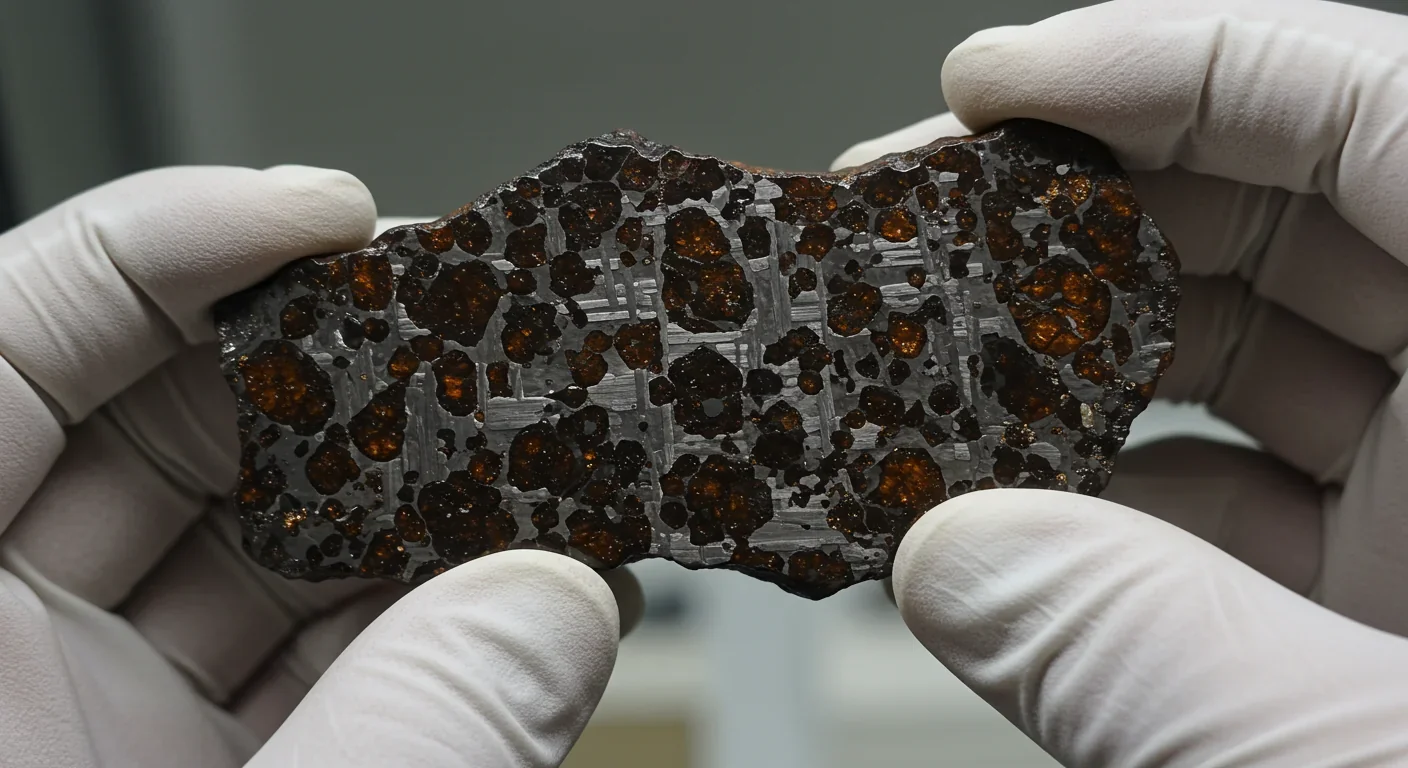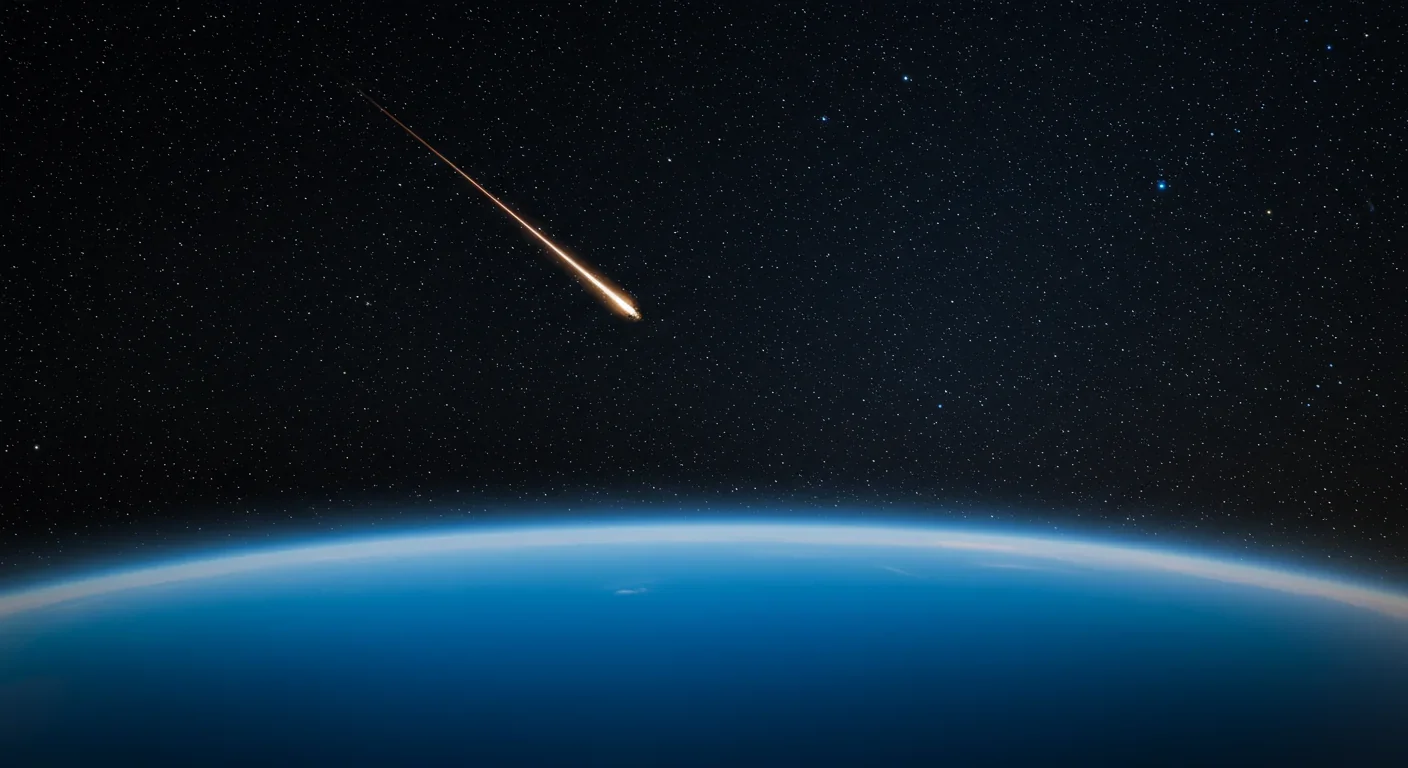The Gravity Heresy: MOND vs Dark Matter Theory Explained

TL;DR: Carbonaceous chondrite meteorites delivered Earth's oceans and the molecular building blocks of life through billions of years of asteroid bombardment, with isotopic fingerprints proving these space rocks carried water identical to our seas.

Four and a half billion years ago, Earth was a molten hellscape. Fast-forward to today, and our planet is the only world we know with oceans deep enough to hide mountain ranges. The transformation is staggering, and the story of how it happened involves billions of asteroid strikes, a special class of space rocks called carbonaceous chondrites, and a cosmic delivery system that also brought the ingredients for life itself.
Recent breakthroughs in isotope analysis and asteroid sample returns are finally settling one of planetary science's biggest debates. The evidence now points clearly to meteorites, specifically carbonaceous chondrites, as the primary source of Earth's water and organic molecules. These ancient rocks, unchanged since the solar system's birth, carried both the seas we swim in and the molecular building blocks that eventually assembled into living cells.
Carbonaceous chondrites are time capsules from the solar system's infancy. Unlike other meteorites that melted and reformed multiple times, these rocks never experienced temperatures above 200°C. They preserve the original composition of the solar nebula, the swirling cloud of gas and dust that collapsed to form our sun and planets 4.6 billion years ago.
What makes them extraordinary is their cargo. Some carbonaceous chondrites contain up to 22% water by weight, locked inside clay minerals and hydrated silicates. That's more water than you'd find in wet beach sand. They also carry up to 3% carbon, present as organic compounds including amino acids, the fundamental units of proteins.
The Murchison meteorite, which fell in Australia in 1969, contains over 96 different amino acids. About 20 of these are the same amino acids used by every living thing on Earth. The rest are molecular cousins that never made it into biology's toolkit, but their presence proves these compounds formed in space, not through contamination after landing.
The case for a meteorite origin for Earth's water rests on a chemical signature as unique as human DNA: the ratio of deuterium to regular hydrogen. Deuterium is hydrogen's heavier cousin, with an extra neutron in its nucleus. Water molecules can contain either normal hydrogen or deuterium, and the ratio between them varies depending on where and how the water formed.
Earth's oceans have a specific deuterium-to-hydrogen ratio, abbreviated D/H. For decades, scientists measured this ratio in comets and found values roughly twice as high as Earth's. That seemed to rule out comets as a major water source. But when researchers analyzed carbonaceous chondrites, they found a D/H ratio nearly identical to our oceans.
The match is so precise it's like finding two puzzle pieces that fit perfectly. CI chondrites, one subtype of carbonaceous chondrites, have water with D/H ratios within 5% of ocean water. That's not coincidence, that's a smoking gun.
More evidence comes from nitrogen isotopes. Earth's atmosphere has a distinctive nitrogen-15 to nitrogen-14 ratio, and carbonaceous chondrites match it closely. The same pattern holds for carbon isotopes. Every measurement points to the same conclusion: Earth's volatiles came from carbonaceous asteroids, not comets or gas from the solar nebula.
Having the right kind of rocks is only half the story. You also need a delivery mechanism capable of transporting quadrillions of tons of material from the asteroid belt to Earth's surface. That mechanism was gravitational chaos combined with sheer brute force.
During the first 500 million years of the solar system's existence, the planets were still settling into their final orbits. Jupiter's massive gravity acted like a cosmic slingshot, flinging asteroids inward toward the sun. Many of these asteroids crossed Earth's orbit, and collisions were inevitable.
The Late Heavy Bombardment, which peaked around 3.9 billion years ago, represents the tail end of this process. During this period, Earth and the Moon were pummeled by asteroid impacts at rates hundreds of times higher than today. The Moon's heavily cratered surface preserves the scars. Earth's craters have been erased by plate tectonics and erosion, but the geological and chemical evidence remains.
Models suggest that carbonaceous chondrites delivered somewhere between one and ten ocean's worth of water during Earth's first billion years. Much of this water was initially lost to space due to impacts and the young sun's intense radiation. But enough stuck around to fill the ocean basins once Earth's surface cooled and solidified.

Water was crucial for life, but it wasn't sufficient. Life also needed carbon-based molecules, energy sources, and a stable environment. Carbonaceous chondrites provided at least two of these three requirements.
The organic inventory of carbonaceous chondrites is staggering. Beyond amino acids, they contain carboxylic acids, alcohols, sugars, nucleobases (the building blocks of DNA and RNA), and complex aromatic hydrocarbons called PAHs. Some meteorites even contain fullerenes, soccer-ball-shaped carbon molecules that can trap other atoms inside their hollow centers.
These compounds formed through chemistry in the cold, radiation-rich environment of space and inside asteroids where liquid water briefly existed. The chemistry wasn't biological, but it was complex enough to produce molecules with a distinct handedness, or chirality. Life on Earth uses exclusively left-handed amino acids, and some carbonaceous chondrites show a preference for left-handed versions with excesses reaching 60%. Whether this preference helped bootstrap biology's own handedness remains an open question, but the correlation is intriguing.
For over a century, scientists studied meteorites that randomly fell from space. They never knew exactly where these rocks came from or what happened to them during their fiery descent through Earth's atmosphere. That changed in September 2023 when NASA's OSIRIS-REx spacecraft returned samples from asteroid Bennu.
Bennu is a carbonaceous asteroid about 500 meters wide that orbits the sun between Earth and Mars. The OSIRIS-REx mission spent two years mapping Bennu's surface before touching down for a brief five-second sample collection. It brought back 250 grams of pristine asteroid material, untouched by Earth's atmosphere or biosphere.
Initial analysis confirmed what meteorite studies suggested: Bennu contains abundant water-bearing minerals and organic compounds, including amino acids. The D/H ratio of water in Bennu's minerals matches Earth's oceans. The asteroid's nitrogen and carbon isotopes also align with terrestrial values.
What surprised researchers was the abundance of carbon. Some Bennu samples contained nearly 5% carbon by weight, higher than most meteorites. Much of this carbon exists as organic molecules, making Bennu one of the most carbon-rich objects ever studied. If Bennu is representative of the asteroids that bombarded early Earth, then our planet received a massive delivery of prebiotic chemistry along with its water.
The mission also revealed fine-grained clay minerals that formed when liquid water altered the asteroid's interior billions of years ago. These clays can trap and concentrate organic molecules, potentially providing a protective environment where simple chemistry could become more complex. Whether this happened on asteroids, in Earth's oceans, or both remains under investigation.
Japan's Hayabusa2 mission returned samples from a different carbonaceous asteroid, Ryugu, in December 2020. Despite Ryugu being a different type of asteroid in a different orbit, the results were remarkably similar to Bennu. Isotopic analysis of Ryugu samples showed water that once flowed inside the asteroid, altering minerals and creating clays.
Ryugu's samples also contained amino acids and other organic molecules. The isotopic composition of these organics indicated they formed in the cold outer solar system and were later incorporated into the asteroid. This suggests that carbonaceous asteroids mixed materials from different regions of the early solar system, creating chemical diversity that eventually reached Earth.
The convergence of evidence from meteorites, Bennu, and Ryugu is powerful. These aren't three different stories, they're three chapters of the same narrative about how rocky bodies in the asteroid belt became the delivery vehicles for Earth's oceans and organic chemistry.
For years, comets were considered the prime candidates for delivering Earth's water. They're icy bodies from the outer solar system, and they obviously contain lots of water. But as measurements accumulated, problems emerged.
Most comets measured so far have D/H ratios about twice Earth's value. This makes sense because comets formed in the cold outer solar system where deuterium is more abundant. A few comets, including Comet 12P/Pons-Brooks, have D/H ratios closer to Earth's, suggesting some comet families might have contributed. But even optimistic models struggle to explain how enough low-D/H comets could have hit Earth to fill the oceans.
There's also a dynamical problem. Comets approaching from the outer solar system hit Earth at extremely high velocities, often over 50 kilometers per second. At these speeds, impacts generate enough heat to vaporize most of the water before it can be retained. Asteroids from the inner solar system arrive at more moderate velocities, increasing the fraction of water that survives impact.
The current scientific consensus is that comets contributed perhaps 10-20% of Earth's water, with carbonaceous asteroids providing the bulk. Some recent studies suggest even this is generous, and comets might have contributed less than 5%. The debate continues, but the evidence increasingly favors asteroids.
Earth's water story has another wrinkle: the Moon-forming impact. About 4.5 billion years ago, a Mars-sized object called Theia collided with the proto-Earth in a catastrophic impact that vaporized both bodies and created a disk of debris that eventually coalesced into the Moon.
This collision should have boiled away Earth's atmosphere and oceans, resetting the planet's volatile inventory to nearly zero. Any water present before the impact would have been lost to space. This means Earth's water must have arrived after the Moon-forming impact, during the subsequent 500 million years of heavy bombardment.
Interestingly, Theia itself might have been rich in water and organics. Some models suggest Theia formed in the outer solar system and migrated inward, potentially delivering volatiles during the very impact that threatened to sterilize Earth. Chemical analysis of Moon rocks shows some water is present, and its isotopic composition matches Earth's, suggesting Theia and Earth shared a similar volatile inventory.
The post-impact bombardment delivered additional water through millions of smaller asteroid impacts. This drawn-out delivery helped Earth accumulate volatiles without losing them all to space, because the planet had time to cool between major impacts.

If carbonaceous asteroids delivered both water and organic molecules, then the ingredients for life arrived together, potentially jump-starting prebiotic chemistry as soon as Earth became habitable. This has profound implications for understanding how quickly life emerged.
The earliest evidence for life on Earth dates to about 3.8-3.5 billion years ago, just a few hundred million years after the Late Heavy Bombardment ended. That's a remarkably short time for chemistry to transition to biology. The abundance of organic compounds delivered by meteorites might explain this speed.
Impact events themselves could have created environments favorable for prebiotic chemistry. When an asteroid hits the ocean, it generates hydrothermal systems where hot, mineral-rich water circulates through fractured rock. These environments concentrate organic molecules, provide energy gradients, and contain catalytic minerals that promote chemical reactions. Some origin-of-life theories propose that life began in similar hydrothermal vents on the ocean floor.
Meteorite impacts on land create impact craters that can fill with water, forming lakes rich in dissolved minerals and organic compounds. These impact-crater lakes represent another potential setting where simple chemistry could become more complex.
The sheer abundance of organic material delivered by carbonaceous chondrites also matters. If every impact dumped tons of amino acids, sugars, and nucleobases onto Earth's surface, then the concentration of these building blocks in early oceans and lakes would have been much higher than most origin-of-life experiments assume. Higher concentrations mean faster reaction rates and more opportunities for complex molecules to form.
Understanding how Earth got its water transforms how we search for life elsewhere. If Earth needed an asteroid bombardment to become habitable, then other rocky planets might require the same process. This has implications for exoplanet habitability.
Many exoplanets orbit red dwarf stars, which are smaller and cooler than the sun. The habitable zone around a red dwarf is much closer to the star than Earth is to the sun. Planets forming this close to their star are likely to be dry, because the high temperatures during formation prevent water ice from condensing.
However, if these planets have asteroid belts beyond their habitable zones, gravitational perturbations could fling water-rich asteroids inward, delivering oceans after the planet forms. Whether this process is common or rare depends on the architecture of other solar systems, something we're just beginning to map with telescopes like JWST.
The presence of water alone doesn't guarantee habitability. You also need organic chemistry, a stable atmosphere, and clement temperatures. But if carbonaceous asteroids are common around other stars, as seems likely given that they're primitive objects that form early in stellar system evolution, then the co-delivery of water and organics might be a universal phenomenon.
This makes the search for biosignatures on exoplanets more hopeful. If getting water and organics to rocky planets is easy, then the limiting factor for life becomes planetary conditions like magnetic fields, plate tectonics, and atmospheric retention. These are challenging to measure but not impossible.
The success of OSIRIS-REx and Hayabusa2 has opened a new era of asteroid sample-return missions. Several more are planned or proposed for the coming decades.
NASA is planning missions to return samples from Mars, which will help answer whether Mars ever had life and what happened to its water. The European Space Agency's Comet Interceptor mission, launching in the 2030s, will visit a pristine comet from the Oort Cloud to measure its composition before solar heating alters it.
There's also growing interest in visiting Ceres, a dwarf planet in the asteroid belt that's essentially a giant carbonaceous asteroid. Ceres is about 900 kilometers wide and might contain a subsurface ocean. Studying Ceres could reveal how water and organic chemistry evolved inside the largest carbonaceous bodies.
Questions remain about the details. How much water and organics did different types of asteroids deliver? Did the composition of incoming asteroids change over time as the solar system evolved? How did Earth retain its volatiles in the face of ongoing impacts? And most intriguingly, did prebiotic chemistry advance significantly inside asteroids before they hit Earth?
Every new meteorite fall, every returned asteroid sample, and every improved isotopic measurement brings us closer to answering these questions. The story of Earth's water is also the story of how our planet became a living world, and understanding it helps us recognize how special, or how common, life-bearing planets might be in the cosmos.
The next time you drink a glass of water, consider its journey. The hydrogen and oxygen atoms in that water formed in the Big Bang and inside dying stars. They came together as ice on asteroids billions of years ago, survived violent impacts, and eventually filled the oceans where life emerged.
Those same asteroid impacts delivered the organic molecules that became the first cells, the first organisms, and eventually us. We are, quite literally, made of stardust delivered by space rocks. The carbonaceous chondrites falling from the sky are our oldest ancestors, carrying messages about where we came from written in isotopes and amino acids.
This knowledge changes how we see ourselves and our place in the universe. Earth wasn't born with oceans, it earned them through billions of years of cosmic bombardment. Life didn't arise spontaneously from nothing, it assembled itself from ingredients delivered by asteroids. And if it happened here, under these specific conditions, it could be happening elsewhere right now, on worlds we haven't discovered yet.
The carbonaceous chondrites taught us that planetary habitability isn't just about being the right distance from a star. It's about the whole history of a solar system, the dance of gravity that flings asteroids across millions of kilometers, and the chemistry that happens inside rocks drifting through space. Understanding this process is understanding our own origin story, written in stone that fell from the sky.

MOND proposes gravity changes at low accelerations, explaining galaxy rotation without dark matter. While it predicts thousands of galaxies correctly, it struggles with clusters and cosmology, keeping the dark matter debate alive.

Ultrafine pollution particles smaller than 100 nanometers can bypass the blood-brain barrier through the olfactory nerve and bloodstream, depositing in brain tissue where they trigger neuroinflammation linked to dementia and neurological disorders, yet remain completely unregulated by current air quality standards.

CAES stores excess renewable energy by compressing air in underground caverns, then releases it through turbines during peak demand. New advanced adiabatic systems achieve 70%+ efficiency, making this decades-old technology suddenly competitive for long-duration grid storage.

Our brains are hardwired to see patterns in randomness, causing the gambler's fallacy—the mistaken belief that past random events influence future probabilities. This cognitive bias costs people millions in casinos, investments, and daily decisions.

Forests operate as synchronized living systems with molecular clocks that coordinate metabolism from individual cells to entire ecosystems, creating rhythmic patterns that affect global carbon cycles and climate feedback loops.

Generation Z is the first cohort to come of age amid a polycrisis - interconnected global failures spanning climate, economy, democracy, and health. This cascading reality is fundamentally reshaping how young people think, plan their lives, and organize for change.

Zero-trust security eliminates implicit network trust by requiring continuous verification of every access request. Organizations are rapidly adopting this architecture to address cloud computing, remote work, and sophisticated threats that rendered perimeter defenses obsolete.